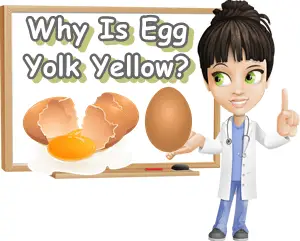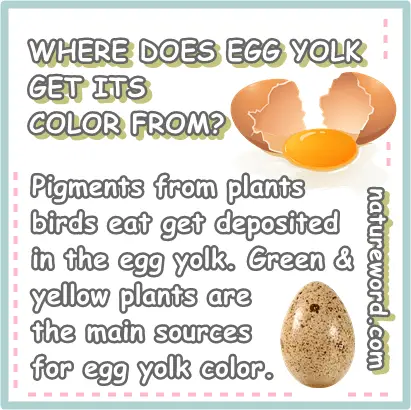The natural color for raw egg yolk is yellow. Depending on the egg variety and individual egg, the shade of yellow may vary from a lighter yellow to a deeper reddish-orange.
But where does egg yolk get its color from? What exactly makes egg yolk yellow? Can egg yolk be another color?
What color is egg yolk normally?
Raw egg white is normally a clear, whitish color, hence the name egg ‘white’. But raw egg yolk is normally yellow.
The exact shade of yellow usually varies between a light, luminous yellow to a deep yellow to an orangey yellow to a reddish orange. The diet of the bird is what will ultimately determine the color of the egg yolk.

Where does egg yolk get its color from?
What makes egg yolk yellow is organic pigments from plants in the bird’s diet.
More specifically, raw egg yolks get their natural color from carotenoid pigments: predominantly yellow xanthophylls, but also smaller amounts of red and orange carotenes. Lecithin, which is naturally yellow-brown, also contributes to the color of egg yolk.
More specifically, egg yolks get their color from xanthophyll pigments.
The types of xanthophylls found predominantly in egg yolk are lutein and zeaxanthin. Both lutein and zeaxanthin are naturally yellow. But egg yolk may also contain smaller amounts of red and orange carotenes such as lycopene.
The lutein and zeaxanthin in the yolk, and other minor pigments, come from plants the bird eats.
Plants naturally high in lutein and zeaxanthin are yellow plants and green plants – in green plants, the yellow pigments are masked by chlorophyll which is green.

How does egg yolk get its yellow color?
Egg yolks get their color from natural pigments from the plants the birds eat.
Yellow and green plants provide most of the pigment in egg yolk, while orange and red plants are minor sources of color. But how does the yolk actually get its color?
Pigments from primarily yellow and green plants in a bird’s diet, and to a lesser extent also red, pink and orange plants, get deposited in the actual egg the bird lays and color the yolk yellow.
The preponderance of yellow and green plants in a bird’s diet has to do with food availability and feeding costs.
For example, grass is free and available plentifully; corn is a staple, also available plentifully; options such as squash and tomatoes, watermelon and other fruits simply cost more which is why they are not a dominant presence in a bird’s diet.
Because the egg white is mostly protein and water, with very small amounts of some water-soluble vitamins, it has almost no color, hence the name egg ‘white’.
But the yolk hosts most of the nutrition of the egg – just as much protein as the egg white, all the fat which has pigment too, the water AND fat-soluble vitamins, and pigments from food which park most of the color in the yolk.
- Find out more about egg yolk nutrition.
- Also see what is the nutrition of one egg yolk.
- Find out more about egg white nutrition.
- Also see what is the nutrition of one egg white.
Foods that make egg yolk color more intense
Egg yolk gets its natural color from organic pigments occurring naturally in the plant foods present in the diet of the bird. The more pigmented foods in a bird’s diet, the more intense the color of the yolk.
The foods that give egg yolks their color yellow include:
- Green plants: grass, alfalfa, clover, green peas, broccoli, Brussels sprouts, lettuce, salad greens (kale, spinach, chard, beet greens, turnip leaves, collard leaves, pumpkin leaves and stems), parsley etc.
- Yellow plant foods: yellow carrots, yellow tomatoes, yellow watermelon, yellow bell peppers and especially corn, corn flour, marigold petals, dandelion flowers, nasturtium flowers, pumpkin and yellow and orange squashes, pumpkin flowers, papaya, apricots, peaches, nectarines etc.
- Red and orange plant foods: red tomatoes, red watermelon, apples, red peppers, pink and red grapefruit and red oranges such as Cara Cara oranges.
All of these foods listed above can be found in a bird’s diet, either provided to them as feed or leftovers, or foraged by the birds themselves. Free range birds will produce eggs whose yolks that are richer in pigments – you can tell this by the intensity of the color that free range eggs input in cooked foods, especially baked goods.
It’s important to note that the color of raw egg yolk is naturally some shade of yellow, whether a paler, more luminous yellow, a more golden yellow or a reddish-orange. But cooked egg yolk can also be yellow with a ring of a grayish olive green. Find out what causes olive green egg yolk in cooked eggs.
